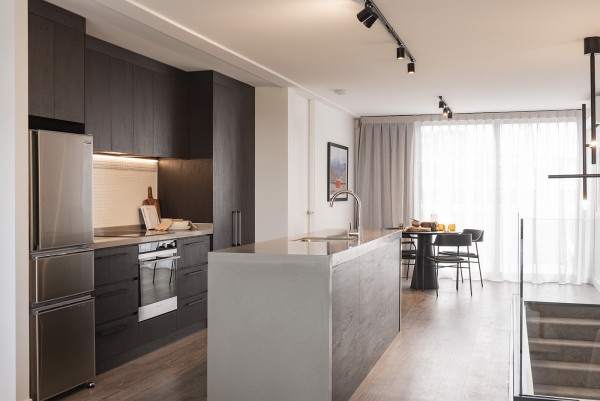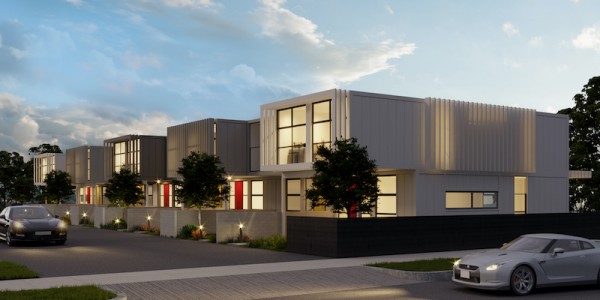From floating prefabricated islands to 140m towers, modular construction is leading the charge in innovative building. While the homes by New Zealand company Modul are more straightforward than tech-heavy developments like the Clement Canopy in Singapore and climate-change combatting projects in Europe, Modul homes are a big step into the future for New Zealand home-buyers.
Around the world, modular construction is using manufacturing tech to enhance traditional building methods. It’s a way of building that may ultimately eclipse the familiar ‘stick building’ approach to construction.
In Singapore, Clement Canopy's 1,899 prefabricated and pre-finished modules were built off-site, with the final structure offering more than 500 apartments, including a swimming pool complex. In Denmark, floating modular islands designed by Australian architects Blecher and Danish firm Studio Fokstrot are planned for Copenhagen harbour. Meanwhile, architecture studio Grimshaw and Dutch manufacturers Concrete Valley are developing prefabricated ‘water dwellings’ for places at risk of flooding due to climate change.
Cutting-edge projects like these rely on developers and architects with an eye for innovation and, to turn that innovation into reality, precision-manufacturing technology.
As a building method, modular construction uses components that are partially or completely assembled in a factory. The manufactured components, often referred to as ‘modules’, are then trucked to the site and installed using a number of construction techniques.
The advantages of the prefab manufacturing process are increased quality control and waste reduction – both at the factory and on building sites – which helps avoid excess costs in building materials. In New Zealand, the cost of building materials is often three to five times the cost of other markets.
Ever heard of the Crystal Palace?
Prefabricated buildings have been around for nearly 200 years. A famous example of early modular construction is the Crystal Palace, built for the “Great Exhibition” in Britain in 1851. It was designed in two weeks and constructed in only a few months.
The first documented prefab houses were built 20 years earlier by London carpenter John Manning. The homes were built in sections and flat-packed for shipping to Australia.
“Some 22,000 of these portable homes were sent to Melbourne during the Gold Rush,” says Tony Houston, Managing Director of Modul. “Our Modul homes are volumetric, not flat-packed, which means the entire home is manufactured and finished in the factory before shipping. Once in New Zealand, the prefabricated “modules” are joined to create two-storey, three-bedroom, terraced Modul homes.”
Prefabricated housing isn’t new in New Zealand either, the Modul difference is that the homes are full-sized (not cottages, sheds or ‘tiny houses’) three-bedroom homes and arrive at the site fully built.
“The idea for Modul grew from the affordable housing projects Tony and I have worked on together over the years,” says Allan Shanahan, who leads the team that designed and planned Modul homes.
“We've adapted the original design to the terrace-type concept for Modul. There has been a lot of development of that early concept to where we are today.”
Modul homes are manufactured in China by one of the world’s leading modular manufacturers that supplies builders and developers all over the world.
Allan visited the factory a number of times. It’s a large facility, on a scale unimaginable for New Zealand, he says. “When we headed to China the second time, it was to see the first three Modul homes that had already been manufactured. This was a quality assurance trip – there were issues we had to work through, of course. But that’s an important part of this process, communicating. Talking to the factory teams to be clear about the kind of high quality product we’re wanting to bring to the Kiwi market.”
For the team at Shanahan Architects, ensuring the design was right for Kiwi lifestyles was a major focus. “We worked to achieve a design that’s broad enough to be a good starter home,” says Allan. “In terms of the planning for Modul, we have done everything we would do when designing a home in the traditional way, with an open-plan layout and indoor-outdoor flow. When doing site layouts, we’re always looking at sun orientation. It’s really the manufacturing and technical side that means we can deliver quality homes at a better price than if we built them here.”
An Auckland-based company, Shanahan Architects has been designing houses in New Zealand for nearly three decades. Allan started the business from his bedroom before moving into an office in Ponsonby. He has been friends with Modul Director Tony Houston since primary school, and they have worked closely together over the years.
“We had our own building company, Shanahan & Houston for a decade, followed by Style Life Homes.” says Allan. “Later, Tony and his wife Robyn had a company that built houses on Auckland’s North Shore, as well as the first house in north-west Auckland’s Hobsonville Point development. Over the years, I was responsible for the design of all the houses their company built there – some 400 homes.”

Inside the Modul show home at Hobsonville Point
Modular homes for Kiwis
For the team at Shanahan Architects, ensuring the design was right for Kiwi lifestyles was a major focus. “We worked to achieve a design that’s broad enough to be a good starter home,” says Allan. “In terms of the planning for Modul, we have done everything we would do when designing a home in the traditional way, with an open-plan layout and indoor-outdoor flow. When doing site layouts, we’re always looking at sun orientation. It’s really the manufacturing and technical side that means we can deliver quality homes at a better price than if we built them here.”
Modernist influenced architecture
“We’ve developed Modul as a modern steel house with a flat roof and lots of glass – the homes have floor-to-ceiling windows,” says Allan.
The initial Modul designs can be seen in the first three homes that arrived at Nugget Avenue in Hobsonville Point, north-west Auckland in June this year. Following on from these, and also in Hobsonville Point, are 10 terrace-type Modul homes and 13 duplexes.
The duplexes offer a different iteration of the Modul prefab concept. “These were a kind of side-dish,” says Allan, “and incorporate the Māori colour palette of red, white and black.”
The Modul team continued to develop the concept to arrive at a standardised design for developments in the Auckland central suburbs of Roskill and Ōwairaka.
“Providing a quality three-bedroom house is our main aim,” says Allan. “The question we asked ourselves was what is a simple, flexible plan that would suit most people looking for an easy, affordable home to live in? Modul is the result.”
Allan says the Roskill homes are based on the design of the first 10 terrace homes in Hobsonville Point, but to a more flexible design that can be used on a much wider selection of sites.
The key Modul difference is the standardised quality, with the cost-savings of modular manufacturing passed on to the buyer.
“There’s always an element of customisation to meet the site requirements,” says Allan. “However, while each of the developments sees a custom colour solution on the exterior of the homes, with pergola and screen elements to differentiate, the homes are identical modular components. There are three interior colour schemes available, but the idea is clever, standardised design and quality materials.”

Each Modul development features different pergola and screen elements on the homes
Affordable design
Advances in modular architecture and construction are firmly linked to urban population growth. New homes using modular construction can be installed on-site more or less in one day, greatly reducing disruption from new building in established urban areas.
The Modul mission is to bring more affordable houses to the New Zealand market. In a parallel project overseas, affordable developer BoKlok, co-owned by Ikea and Skanska, has plans approved to build low-cost housing in the south of England. A percentage of the homes are to be used as social housing in return for use of the land, with the remaining homes available through the developer’s affordable housing model.
The approach is similar to the builder-partner arrangement overseen by government agency Kāinga Ora – Homes and Communities here in New Zealand. As a Kāinga Ora builder partner, Modul is offering a percentage of its homes at affordable and open market prices. This partnership comes under the Auckland Housing Programme, aimed at bringing better social housing and more affordable homes to Kiwi buyers.
As the need for smart housing solutions and sustainable homes increases, modular building is one of the ways we can meet the demand for affordable housing in New Zealand – and around the world.
